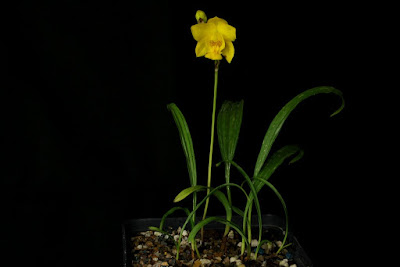Spathoglottis ixioides is found in Bhutan, India (Sikkim), Nepal. It grows on moist moss covered rocks in dense mixed forests and on wet roadside banks with scattered scrub at elevations of 1950 to 3650 meters above sea level.
Spathoglottis ixioides also called as The Ixia-Like Spathoglottis, Cymbidium ixioides, is a species of the genus Spathoglottis. This species was described by John Lindley in 1831.
IDENTIFY SPATHOGLOTTIS IXIOIDES ORCHID PLANT
Spathoglottis ixioides is found in Bhutan, India (Sikkim), Nepal. It grows on moist moss covered rocks in dense mixed forests and on wet roadside banks with scattered scrub at elevations of 1950 to 3650 meters above sea level.
It is a miniature sized, cool to cold growing terrestrial- lithophyte with small compressed, globose-ovoid, 0.5-1 cm in diameter pseudobulbs enveloped basally by fibroses sheaths and carrying 1 to 2 plicate, distichous, linear to oblong, acuminate, sessile, 6-12 x 0.3-1.1 cm leaves.
The Ixia-Like Spathoglottis blooms in the mid-summer on a 10 cm long, 1 to 3 flowered inflorescence. The flowers are yellow; pedicel and ovary, densely villous. Dorsal sepal elliptic, 5- or 6-veined, outer surface sparsely villous, apex acute; lateral sepals ovate-lanceolate to oblong-lanceolate, outer surface sparsely villous. Petals 7-veined, apex subobtuse; lip erect, saccate at base, 3-lobed, with 2 acute auricles at base of claw; disk with 1 keel; lateral lobes ovate-triangular, shallowly incised, apex obtuse; mid-lobe obovate, with a short claw at base, apex subtruncate; disk with a low, central ridge running from middle of claw to midway along mid-lobe; keel arising from base of lip, usually densely pubescent, dividing before claw into 2 large, fleshy, rounded-obtuse extensions and terminating at base of mid-lobe.
SPATHOGLOTTIS IXIOIDES ORCHID PLANT CARE AND CULTURE
Cultural information should only be used as a guide, and should be to be adapted to suit you. Your physical location; where you grow your plants, how much time you have to devote to their care, and many other factors, will need to be taken into account. Only then can you decide on the cultural methods that best suit you and your plants.
Light:
Spathoglottis ixioides like indirect sunlight. 20000 - 50000 lux or speckled sunlight protected from the hottest direct sunlight of the day, 7500 lux for the youngest plants. If the plants don’t bloom, the amount of direct sunlight the plants are receiving has to increase.
Temperature:
The Ixia-Like Spathoglottis are generally warm growing plants liking temperatures up to the high 30˚ C. They need cool to cold temperatures in winter of between 1 and 5°C. They drops the leaves in mid September when the plant should be kept dry until new growth appears in the late winter to early spring.
Humidity:
This orchids prefer high level of humidity for better growth. Humidify the air around the plant is necessary for flowering. Misting plants daily is also effective .Grower can place a humidifier near the orchids to maintain the humidity. A pebble tray filled with water and placed underneath orchid pots also keeps air moist.
Substrate, growing media and repotting:
Spathoglottis ixioides are very forgiving as to the potting media. You can use a media based on 75% high quality soilless mix used for hanging baskets and larger containers mixed with 25% our orchid potting media which incorporates expanded slate. Outdoor landscaping media can incorporate more orchid media for drainage - bark, perlite, sphagnum moss, and various other components. The mix is very free draining but holds more moisture than regular media for epiphytic orchids.
The plant should be repotted when they are dormant in winter or when the soil has become depleted. Their root systems are fairly extensive for their size. Make sure not to damage them.
Watering:
This species require good drainage in the media, so after a thorough watering allow the media to dry on top but you do not want the container to dry out altogether. Do not allow to sit in water. Water thoroughly in the morning once to twice weekly depending on your cultural conditions (light, temperature, humidity, air movement, etc.) allowing the top of the media to dry slightly between waterings. If the potting media is top-dressed with expanded slate, the area next to the pseudobulbs will dry out nice and quickly. In winter, the amount of water should reduced or completely eliminated.
Fertilizer:
Spathoglottis ixioides like fairly high feedings of fertilizer with every watering. In outdoors, use of any slow release fertilizer containing equal parts nitrogen, phosphorus and potassium and micronutrients in the 4 - 6 months release formulations gives better growth. Fertilization with diluted fertilizer (1/4 strength) every two to three weeks interval is also effective. Fertilizers with trace elements of iron and magnesium should not be used as a chemical imbalance may occur that can be harmful to the plants. Don't fertilize the plant when they are dormant.















COMMENTS